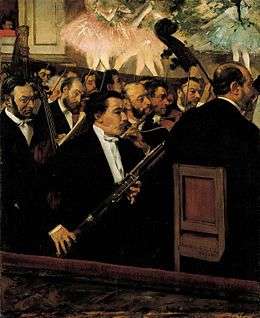Trio for oboe, bassoon and piano
| Trio pour hautbois, basson et piano | |
|---|---|
| Chamber music by Francis Poulenc | |
 The orchestra, painting by Edgar Degas. In the foreground in the center, the bassoonist, one of the three instrumentalists of the trio of Poulenc with the oboist and the pianist | |
| Catalogue | FP 43 |
| Composed | 1926 |
| Dedication | Manuel de Falla |
| Performed | 2 May 1926: Paris |
The Trio pour hautbois, basson et piano (Trio for oboe, bassoon and piano), FP 43, by Francis Poulenc is a piece of chamber music, composed in 1926.
Genesis
Composed at Cannes in 1926, the trio is dedicated to Manuel de Falla, who particularly appreciated it.[H 1] It was premiered on 2 May 1926 at the same time as the Chansons gaillardes.[1]
Reception and legacy
Biographer Henri Hell praises this new piece of chamber music by specifying "the perfect coherence of its construction of an equilibrium as innate, that does not spoil any length, no development".[H 2] "The trio will be revived on 27 May 1959 at the concert of the salle Gaveau in Paris celebrating the 60th anniversary of the composer."[H 3]
Style
If several themes recall Mozart, notably the first measures of the Andante, this trio is considered by some to be the first important work of the composer's repertoire of chamber music because it intensely reflects the personality of Poulenc.[H 1]
Structure and analysis
Structure
Like most of the composer's works of chamber music, this trio has three movements on the vif - lent - vif model:
- Presto
- Andante
- Rondo
Analysis
Presto
A short introduction in chords played on the piano precedes the introduction of a humorous melody to the bassoon. The oboe enters its treble, joined by the piano and the bassoon. The introduction leaves room for the presto "muscular and spiritual" in the words of Henri Hell.[H 4] It is a kind of French overture.[M 1]
Andante
The piano exposes the theme before the entrance of the bassoon and the oboe. The voices of the two woods are mingled with those of the piano. The melody of a "melancholy grace" is more particularly entrusted to the oboe.[H 4]
Rondo
With a very lively rhythm, this third and final movement mixes the lightness of the bassoon and the "ironic voice"[H 2] of the oboe.
Selected discography
- Francis Poulenc - Intégrale Musique de chambre - RCA Red Seal : François Leleux (oboe), Gilbert Audin (bassoon), Éric Le Sage (piano) ;
References
- ↑ Sleeve of the record Francis Poulenc - Intégrale Musique de chambre - RCA Red Seal, p. 9
- ↑ p. 50
Bibliography
- Hell, Henri (1978). Francis Poulenc (in French). Fayard. p. 388. ISBN 2-213-00670-9.
- Machart, Renaud (1995). Poulenc (in French). Éditions du Seuil. p. 252. ISBN 2-02-013695-3.
External links
- Trio for oboe, bassoon and piano: Scores at the International Music Score Library Project (IMSLP)
- Francis Poulenc - Trio for Piano, Oboe & Bassoon on YouTube
- Poulenc — Trio for Oboe, Bassoon, and Piano on Paul Thomason writer.com